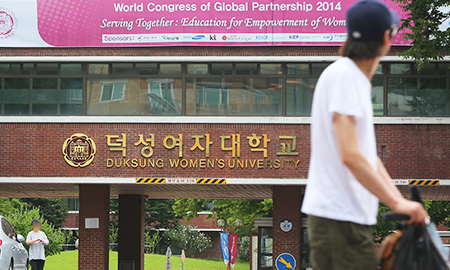- California Assembly OKs highest minimum wage in nation
- S. Korea unveils first graphic cigarette warnings
- US joins with South Korea, Japan in bid to deter North Korea
- LPGA golfer Chun In-gee finally back in action
- S. Korea won’t be top seed in final World Cup qualification round
- US men’s soccer misses 2nd straight Olympics
- US back on track in qualifying with 4-0 win over Guatemala
- High-intensity workout injuries spawn cottage industry
- CDC expands range of Zika mosquitoes into parts of Northeast
- Who knew? ‘The Walking Dead’ is helping families connect
Women’s universities in South Korea are fighting for survival

A man walks past the main gate of Duksung Women’s University in Seoul in this Aug. 3, 2014, file photo. The university’s president, Rhie Won-bok, recently said he wants to make the women-only school coeducational. (Yonhap)
By Lee Kyung-min
Women’s universities in South Korea are losing their edge as gender-oriented ivory towers, with some of them considering recruiting male students.
One of the biggest challenges for them is the employment rate of graduates, which is lower than coed universities.
In addition, female students seem to prefer coed setting.
Women’s universities lack “male dominant” departments such as engineering, but have relatively bigger “female dominant” departments such as liberal arts, the humanities and design.
Engineering graduates have a higher employment rate even amid the current harsh economic climate, while liberal art graduates are the opposite.
Although failure to attract college applicants has been a problem for decades, the concern resurfaced after Duksung Women’s University President Rhie Won-bok announced a plan last week to make the university coeducational, adding that the school’s survival would depend on it.
His announcement came after the university suffered a cut in government subsidies because it was among the bottom 15 percent of the worst performing schools in an annual evaluation survey conducted by the Ministry of Education. Graduate employment rates are part of the ministry’s evaluation criteria.
In the 1990s, four women-only universities turned coed. Currently, there are seven women-only universities ― Ewha, Sookmyung, Sungshin, Seoul, Duksung, Dongduk and Kwangju.
In 1994, Sungshim Women’s University merged with the Catholic University of Korea, while Hyosung Women’s University was taken over by the Catholic University of Daegu.
Sangmyung Women’s University became coed in 1996; as did Busan Women’s University in 1997, which then changed its name to Silla University.
According to experts, their decisions to become coed were necessary as female students were opting for coed institutions, according to an expert.
“Korea is already known for its heated competition to enter prestigious universities. Many female students who went to all-girls high schools think they suffered enough tension there, and refuse to go through the same experience. For those who went to coed high schools, entering women-only universities would almost never enter their mind,” said Lee Young-duk, a counselor at Daesung IC, a cram school.
“They prefer to be in an environment with both men and women because it obviously dilutes the tension by driven and sometimes overachieving women,” he added.
A lack of social contact also contributes to the reluctance, according to an expert.
“Women with jobs are more likely to be absent from social interaction than men because, when they get married and get pregnant, raising children becomes their primary responsibility. And compared to those from the coed universities, I think young female students feel that the chance of benefitting from the university alumni is less likely if they choose an all-women university,” said an instructor at Seoul-based university on condition of anonymity.
What the women-only universities represented in the past has largely faded, the instructor added.
“Just 40 years ago, women were severely repressed, politically, socially, not to mention at home.” The instructor said. ”But times are different now, at least for young adults in their early 20s. They no longer recognize the social significance of the foundation of women-only universities. Women being denied an education is ancient history to them. Also, nowadays, advocating for women’s rights is largely distorted by extreme feminists. Young women do not like that,” he added.
“Women-only universities would have hard time attracting students asserting such an idea in the current environment of what many say is improved gender equality. I think many would be rather repulsed by the political overtones.”















